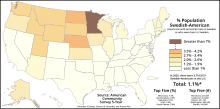
Back أمريكيون سويديون Arabic Schwedenamerikaner German Svedaj usonanoj Esperanto آمریکاییهای سوئدیتبار Persian Amerikanruotsalaiset Finnish Suédo-Américains French Swedia Amerika ID スウェーデン系アメリカ人 Japanese 스웨덴계 미국인 Korean Amerykanie pochodzenia szwedzkiego Polish
 | |
| Total population | |
|---|---|
| 3,322,477 (1.0%) alone or in combination 768,809 (0.2%) Swedish alone | |
| Regions with significant populations | |
| Most prevalent in the Midwestern United States | |
| 410,091 | |
| 357,926 | |
| 241,187 | |
| 209,559 | |
| 143,896 | |
| 140,123 | |
| 138,599 | |
| 132,003 | |
| 122,644 | |
| Languages | |
| American English (accent), Swedish | |
| Religion | |
| Predominantly Lutheranism (denominations), Protestantism, Mormonism | |
| Related ethnic groups | |
| Swedes, Swedish Britons, Swedish Canadians, Swedish Australians, Scandinavian Americans, Danish Americans, Norwegian Americans, Icelandic Americans | |


Swedish Americans (Swedish: svenskamerikaner) are Americans of Swedish descent. The history of Swedish Americans dates back to the early colonial times,[3] with notable migration waves occurring in the 19th and early 20th centuries and approximately 1.2 million arriving between 1865–1915.[4] These immigrants settled predominantly in the Midwest, particularly in states like Minnesota, Illinois, and Wisconsin, in similarity with other Nordic and Scandinavian Americans. Populations also grew in the Pacific Northwest in the states of Oregon and Washington at the turn of the twentieth century.
As a community, Swedish Americans have contributed to various aspects of American life, including politics, the arts, sciences, and business. They brought with them distinct cultural traditions like unique culinary practices, language, and celebrations such as Midsummer. These traditions are preserved by institutions such as the American Swedish Institute in Minneapolis,[5] the American Swedish Historical Museum in Philadelphia,[6] Chicago's Swedish American Museum, and the Gammelgården Museum in Scandia, Minnesota.[7]
- ^ "IPUMS USA". University of Minnesota. Archived from the original on October 13, 2022. Retrieved October 12, 2022.
- ^ Demitz, Jacob Truedson (March 26, 2021). Grenstam (in Swedish). Books on Demand. pp. 25, 43, 114, 116, 143. ISBN 978-91-633-1485-8.
- ^ Köhlin, Harald (1948). "First Maps of Delaware, a Swedish Colony in North America". Imago Mundi. 5: 78–80. doi:10.1080/03085694808591907. ISSN 0308-5694. JSTOR 1149789.
- ^ Lindmark, Sture, 1936– (1971). Swedish America, 1914-1932. Studies in ethnicity with emphasis on Illinois and Minnesota. Stockholm: Läromedelsförlaget. ISBN 9124686840. OCLC 427933.
{{cite book}}: CS1 maint: multiple names: authors list (link) CS1 maint: numeric names: authors list (link) - ^ "Mission & Values". American Swedish Institute. October 5, 2021. Retrieved December 5, 2023.
- ^ "Connecting Cultures and Community". American Swedish Historical Museum. Retrieved December 5, 2023.
- ^ "Välkommen". Gammelgården Museum. November 5, 2023. Retrieved December 5, 2023.
© MMXXIII Rich X Search. We shall prevail. All rights reserved. Rich X Search